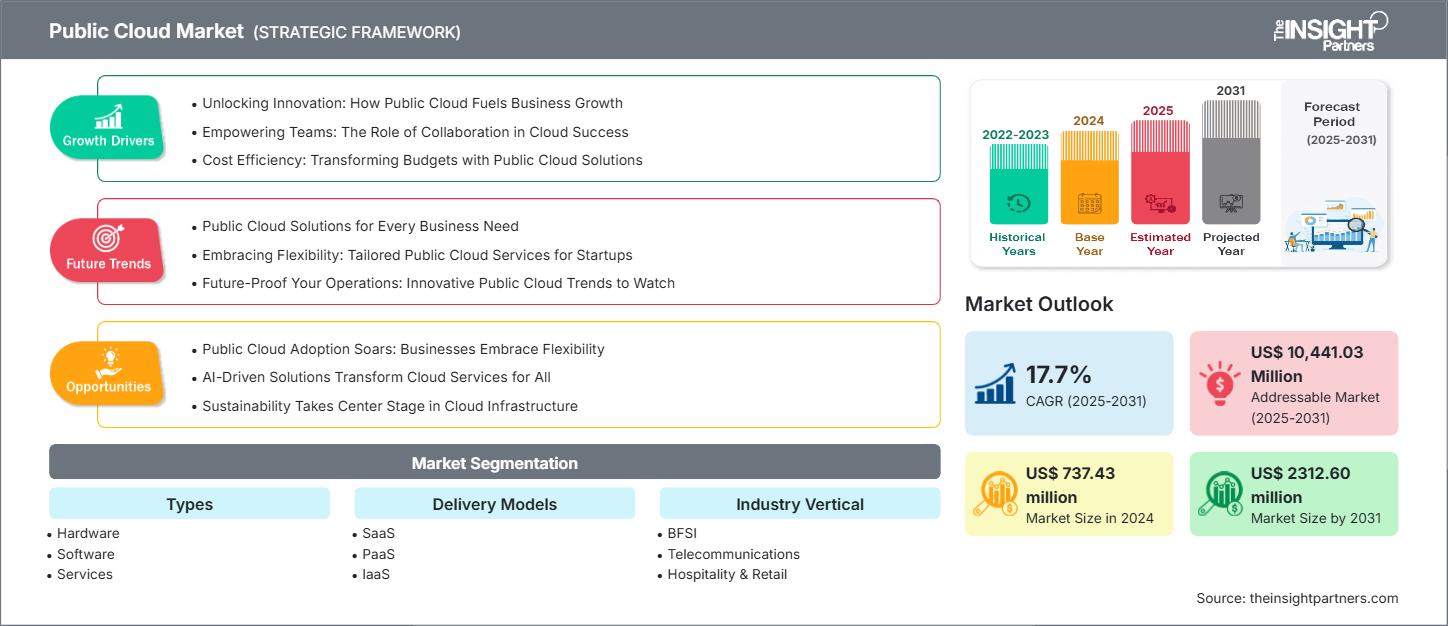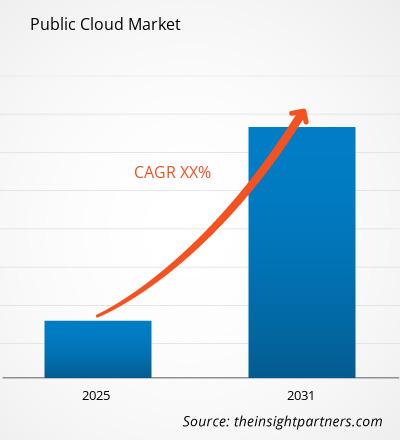퍼블릭 클라우드 시장 규모는 2031년까지 6,844억 7천만 달러에 이를 것으로 예상됩니다. 이 시장은 2025년부터 2031년까지 14.8%의 CAGR을 기록할 것으로 예상됩니다.
클라우드 서비스는 조직의 데이터를 다양한 목적으로 저장하는 저장소 또는 서드파티 공급업체 역할을 합니다. 저장된 데이터는 분석 목적으로 검색됩니다. 퍼블릭 클라우드 도메인은 원격으로 액세스할 수 있는 공용 네트워크를 통해 제공되는 클라우드 서비스를 의미합니다. 퍼블릭 클라우드 모델의 가장 큰 장점은 조직의 데이터 저장 및 유지 관리에 대한 우려가 적다는 것입니다. 오프프레미스(off-premise) 방식으로 구축되며, 여러 조직이 서드파티 공급업체의 컴퓨팅 공간을 공유하는 멀티테넌트 아키텍처를 사용합니다. 중소기업은 데이터 저장 및 유지 관리를 서드파티 클라우드 공급업체에 아웃소싱하여 인프라 구축에 드는 자본 투자를 크게 절감할 수 있으므로 더 많은 이점을 얻을 수 있습니다. 비용 절감, 신속한 구축 및 테스트, 그리고 제품 출시 기간 단축은 다양한 산업 분야의 많은 기업들이 퍼블릭 클라우드 기술을 도입하는 데 큰 도움이 되었습니다.
이 보고서의 일부 또는 국가 수준 분석, Excel 데이터 팩을 포함하여 모든 보고서에 대한 사용자 정의를 무료로 받을 수 있으며, 스타트업 및 대학을 위한 훌륭한 혜택과 할인도 이용할 수 있습니다.
퍼블릭 클라우드 시장: 전략적 통찰력

- 이 보고서의 주요 시장 동향을 알아보세요.이 무료 샘플에는 시장 동향부터 추정치 및 예측까지 다양한 데이터 분석이 포함됩니다.
지난 10년 동안 소프트웨어 산업은 엄청난 변화를 겪었습니다. 특히 기업들이 클라우드 모델을 도입하는 것은 클라우드가 제공하는 장점으로 인해 가장 두드러집니다. 기업의 확장성이 뛰어나 사용자 요구에 따라 스토리지 센터의 데이터를 확장하거나 축소할 수 있는 클라우드 기반 서비스를 선택하는 경향이 있습니다. 또한, 퍼블릭 클라우드 공급업체의 가격 구조는 일반적으로 사용량 기반 과금제입니다. 특히 중소기업은 한꺼번에 많은 비용을 지불할 필요가 없기 때문에 퍼블릭 클라우드 모델을 비즈니스 운영에 도입하는 것이 매우 바람직합니다. 기업의 핵심 역량이 유지되고, 따라서 역동적인 시장에서 경쟁력을 유지할 수 있습니다. 운영 비용 절감과 단일 공급업체에서 제공하는 다양한 비즈니스 맞춤형 솔루션은 퍼블릭 클라우드 서비스 시장의 주요 성장 동력입니다. 확장 가능하고 유연하며 사용하기 쉽고 효율적인 IT 인프라에 대한 수요 또한 이 시장을 크게 성장시키고 있습니다. 운영이 전적으로 기계로 이루어지기 때문에 인적 오류가 최소화되고, 궁극적으로 기업들이 퍼블릭 클라우드 서비스를 도입하게 되는 이유입니다. 위에서 언급한 요인들이 이 시장의 기하급수적인 도입을 뒷받침하는 요인입니다. 전 세계 선진국에서 퍼블릭 클라우드 서비스가 상당히 많이 도입되었음에도 불구하고, 퍼블릭 클라우드 서비스의 성장은 별다른 제약을 받지 않았습니다. 데이터 프라이버시와 관련된 보안 문제는 이 시장의 주요 제약 요인이었습니다. 이 클라우드 모델은 인터넷 연결 요건이 높기 때문에 연결성이 낮은 국가에서는 퍼블릭 클라우드 구현에 영향을 미칠 수 있습니다. 또한, 이 모델과 기존 시스템의 통합 또한 제약 요인이었습니다. 이 시장의 다른 제약 요인으로는 서비스 중단 및 데이터 이동성 등이 있습니다.
퍼블릭 클라우드 시장 지역별 통찰력
The Insight Partners의 분석가들은 예측 기간 동안 퍼블릭 클라우드 시장에 영향을 미치는 지역별 동향과 요인을 면밀히 분석했습니다. 이 섹션에서는 북미, 유럽, 아시아 태평양, 중동 및 아프리카, 중남미 지역의 퍼블릭 클라우드 시장 부문 및 지역별 현황도 살펴봅니다.
퍼블릭 클라우드 시장 보고서 범위
| 보고서 속성 | 세부 |
|---|---|
| 2024년 시장 규모 | XX억 달러 |
| 2031년까지 시장 규모 | 6,844억 7천만 달러 |
| 글로벌 CAGR(2025~2031년)CAGR (2025 - 2031) | 14.8% |
| 역사적 데이터 | 2021-2023 |
| 예측 기간 | 2025-2031 |
| 다루는 세그먼트 | 유형별
|
| 포함된 지역 및 국가 | 북아메리카
|
| 시장 선도 기업 및 주요 회사 프로필 |
|
퍼블릭 클라우드 시장 참여자 밀도: 비즈니스 역학에 미치는 영향 이해
퍼블릭 클라우드 시장은 소비자 선호도 변화, 기술 발전, 그리고 제품 이점에 대한 인식 제고 등의 요인으로 인한 최종 사용자 수요 증가에 힘입어 빠르게 성장하고 있습니다. 수요가 증가함에 따라 기업들은 제품 및 서비스를 확장하고, 소비자 니즈를 충족하기 위한 혁신을 추진하며, 새로운 트렌드를 적극 활용하고 있으며, 이는 시장 성장을 더욱 가속화하고 있습니다.

- 퍼블릭 클라우드 시장의 주요 기업 개요를 알아보세요
글로벌 퍼블릭 클라우드 시장은 하드웨어, 소프트웨어, 서비스로 유형별로 세분화되었습니다. 또한 퍼블릭 클라우드 시장은 제공 모델에 따라 SaaS, PaaS, IaaS로 세분화되었습니다. 또한, 최종 사용자, 즉 중소기업과 대기업을 기준으로도 세분화되었습니다. 퍼블릭 클라우드 시장은 BFSI, 통신, 호텔 및 소매, 정부, 제조, 의료를 포함한 산업 분야별로도 세분화됩니다. 북미는 놀라운 기술 발전과 사회경제적 발전으로 글로벌 퍼블릭 클라우드 시장을 선도하고 있습니다. 또 다른 주요 산업 중심지인 유럽은 퍼블릭 클라우드 시장 성장에 기여해 왔습니다. 소규모 산업이 많은 유럽의 북유럽 지역은 유럽 퍼블릭 클라우드 시장 점유율에 크게 기여했습니다. 또한, 인도와 중국과 같은 개발도상국이 점차 퍼블릭 클라우드 기술에 투자하면서 아시아 태평양 지역도 이러한 지역을 꾸준히 따라잡고 있습니다. 글로벌 퍼블릭 클라우드 시장에서 활동하는 주요 기업으로는 Microsoft Corporation, Salesforce.com, Cisco Systems, Inc., VMWare, Google, Inc., Oracle Corporation, Eucalyptus 등이 있습니다.
- 과거 분석(2년), 기준 연도, CAGR을 포함한 예측(7년)
- PEST 및 SWOT 분석
- 시장 규모 가치/거래량 - 글로벌, 지역, 국가
- 산업 및 경쟁 환경
- Excel 데이터세트
최근 보고서
사용 후기
구매 이유
- 정보에 기반한 의사 결정
- 시장 역학 이해
- 경쟁 분석
- 고객 인사이트
- 시장 예측
- 위험 완화
- 전략 기획
- 투자 타당성 분석
- 신흥 시장 파악
- 마케팅 전략 강화
- 운영 효율성 향상
- 규제 동향에 발맞춰 대응




















 무료 샘플 받기 - 퍼블릭 클라우드 시장
무료 샘플 받기 - 퍼블릭 클라우드 시장